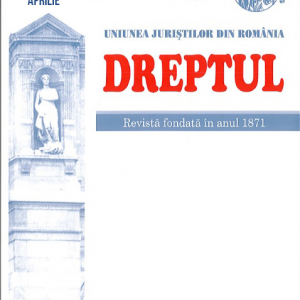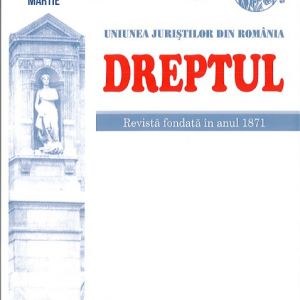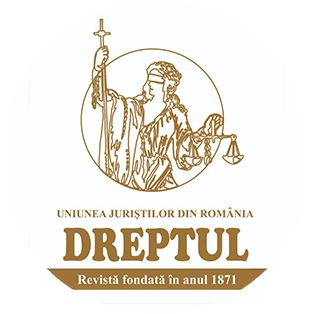-
 Law no. 287/2009 regarding the Civil Code introduces in the matter of successoral option many new items here and there, reconfiguring it. In this study, we propose to examine the general aspects that the successoral option involves in the light of the provisions of the new Civil Code, to highlight the new items brought by this legislative instrument in the matter subject to the examination et to assess their progressive nature.
Law no. 287/2009 regarding the Civil Code introduces in the matter of successoral option many new items here and there, reconfiguring it. In this study, we propose to examine the general aspects that the successoral option involves in the light of the provisions of the new Civil Code, to highlight the new items brought by this legislative instrument in the matter subject to the examination et to assess their progressive nature. -
 In this study, the author carries out a critical analysis of the provisions of articles 508-534 of the current Civil Code (Law no. 287/2009, as republished on 15 July 2011 and which came into force on the 1st of October 2011), texts which regulate „the legal obligation to support”. Essentially, the author, after emphasizing a series of new judicious and useful regulations of the above mentioned texts of the current Civil Code shows at the same time numerous deficiencies of articles 508-534 of the Civil Code which has recently become effective and which, in his opinion, involves many amendments, supplements and even abolitions of the concerned rules.
In this study, the author carries out a critical analysis of the provisions of articles 508-534 of the current Civil Code (Law no. 287/2009, as republished on 15 July 2011 and which came into force on the 1st of October 2011), texts which regulate „the legal obligation to support”. Essentially, the author, after emphasizing a series of new judicious and useful regulations of the above mentioned texts of the current Civil Code shows at the same time numerous deficiencies of articles 508-534 of the Civil Code which has recently become effective and which, in his opinion, involves many amendments, supplements and even abolitions of the concerned rules. -
 In this study the author analyses the individual amnesty at the level of the constitutional disposition, in the light of the compared law as a prerogative of the head of State. Covering this analysis, the author concludes that the deed of individual amnesty represents a discretionary and sovereign duty known in most cases as a prerogative of the executive body which exercises this prerogative being able to pardon, usually, without any justification, any individual, no matter the offence he/she committed, provided that he/she was finally sentenced.
In this study the author analyses the individual amnesty at the level of the constitutional disposition, in the light of the compared law as a prerogative of the head of State. Covering this analysis, the author concludes that the deed of individual amnesty represents a discretionary and sovereign duty known in most cases as a prerogative of the executive body which exercises this prerogative being able to pardon, usually, without any justification, any individual, no matter the offence he/she committed, provided that he/she was finally sentenced. -
 In this study, the author, after having pointed out the need for taking certain measures on combating the organized crime at the European level in compliance with the actions of the United Nations Organization in the matter, discloses, on one hand, the measures adopted at the level of the European Union regarding the incrimination of deeds regarding the crime organization and, on the other hand, examines the provisions of the framework decision of the Council 2008/ 841/JAI of 24 October 2008 regarding the fight against organized crime. Likewise, the author describes the implications of these measures on the criminal laws of Romania.
In this study, the author, after having pointed out the need for taking certain measures on combating the organized crime at the European level in compliance with the actions of the United Nations Organization in the matter, discloses, on one hand, the measures adopted at the level of the European Union regarding the incrimination of deeds regarding the crime organization and, on the other hand, examines the provisions of the framework decision of the Council 2008/ 841/JAI of 24 October 2008 regarding the fight against organized crime. Likewise, the author describes the implications of these measures on the criminal laws of Romania. -
 Certain considerations are mentioned in this study regarding the privilege of the confidentiality of the journalists’ information sources. To this end, there is carried out an interesting description of the European conception on the confidentiality of information sources (case law of the European Court of Human Rights; Swedish, German, British, Belgian, French laws), of the conception in the matter of the laws and case law of the United States of America, as well as of the Romanian conception, finally. The study concludes by emphasizing the need for the adoption of a modern Romanian mass-media law, pointing out that the freedom of the media can never be absolute and consequently, may be limited by legal exception rules of interpretation strictly.
Certain considerations are mentioned in this study regarding the privilege of the confidentiality of the journalists’ information sources. To this end, there is carried out an interesting description of the European conception on the confidentiality of information sources (case law of the European Court of Human Rights; Swedish, German, British, Belgian, French laws), of the conception in the matter of the laws and case law of the United States of America, as well as of the Romanian conception, finally. The study concludes by emphasizing the need for the adoption of a modern Romanian mass-media law, pointing out that the freedom of the media can never be absolute and consequently, may be limited by legal exception rules of interpretation strictly. -
 The globalization phenomenon is inevitably leading to a development, without precedent, of the international trade, in general, and of the freight, a situation that emphasizes the current complex issue of defining the law applicable to the international contract of maritime freight, and also the enhancement of afforts for the elaboration of an uniform frame applicable to international trade contracts in general, by the specialized institutions – UNCITRAL, UNIDROIT, the Hague Conference on international private law; the existence of an uniform law proves to be the best solution in order to avoid difficult issues caused by the conflict of laws, process which is constantly developing without achieving the elaboration of an universal interstate convention, that could unify the conflict solutions applicable to all international trading contracts, and consequently, at least for the time being, the conflict of laws is not completely eliminated. From this perspective, the law applicable to the international charter party has been analyzed according to the European Committee Regulation no. 593/ 2008 of the Europea Parliament and Council regarding the law applicable on contractual obligations – Rome I, and according to the inter-American Convention on the law applicable on international contracts (CIDIP Convention).
The globalization phenomenon is inevitably leading to a development, without precedent, of the international trade, in general, and of the freight, a situation that emphasizes the current complex issue of defining the law applicable to the international contract of maritime freight, and also the enhancement of afforts for the elaboration of an uniform frame applicable to international trade contracts in general, by the specialized institutions – UNCITRAL, UNIDROIT, the Hague Conference on international private law; the existence of an uniform law proves to be the best solution in order to avoid difficult issues caused by the conflict of laws, process which is constantly developing without achieving the elaboration of an universal interstate convention, that could unify the conflict solutions applicable to all international trading contracts, and consequently, at least for the time being, the conflict of laws is not completely eliminated. From this perspective, the law applicable to the international charter party has been analyzed according to the European Committee Regulation no. 593/ 2008 of the Europea Parliament and Council regarding the law applicable on contractual obligations – Rome I, and according to the inter-American Convention on the law applicable on international contracts (CIDIP Convention). -
 Commenting on a judgment pronounced by Craiova Court of Appeal, the author makes certain considerations related, on one hand, to the prosecutor’s right to declare the appeal regarding the civil side for lack of appeal of the civil party and, on the other hand, to the effects of the second appeal in the criminal proceedings.
Commenting on a judgment pronounced by Craiova Court of Appeal, the author makes certain considerations related, on one hand, to the prosecutor’s right to declare the appeal regarding the civil side for lack of appeal of the civil party and, on the other hand, to the effects of the second appeal in the criminal proceedings. -
 In this study, the author carries out a detailed analysis of the content of the offence regulated by art. 2803 of Law no. 31/1990 on companies, as republished, subsequently amended and supplemented, criticizing a series of opinions expressed in the specialty literature regarding the constituent elements of this offence. In the last part of the publication, the author raises the question of autonomy of the examined offence as compared to the offence regulated under art. 291 of the Criminal Code (art. 323 of the new Criminal Code), proposing certain criteria for the classification of these two offences.
In this study, the author carries out a detailed analysis of the content of the offence regulated by art. 2803 of Law no. 31/1990 on companies, as republished, subsequently amended and supplemented, criticizing a series of opinions expressed in the specialty literature regarding the constituent elements of this offence. In the last part of the publication, the author raises the question of autonomy of the examined offence as compared to the offence regulated under art. 291 of the Criminal Code (art. 323 of the new Criminal Code), proposing certain criteria for the classification of these two offences. -
 In this study, the author analyses the offence of disturbance of possession both from the diachronic perspective and in the light of the applicable, but also future criminal laws. From the historical perspective, the author states that the amendments that the new Criminal Code brings in relation to the abovementioned offence cause the regulation to be similar to the provisions of art. 556558 of the Criminal Code „Carol II who punished the committed offence by moving the boundary limits, by threat and violence and of art.220 of the Criminal Code of 1968, in its original version, for the simple occupation without being entitled, the owner having the use of possession actions at his disposal.
In this study, the author analyses the offence of disturbance of possession both from the diachronic perspective and in the light of the applicable, but also future criminal laws. From the historical perspective, the author states that the amendments that the new Criminal Code brings in relation to the abovementioned offence cause the regulation to be similar to the provisions of art. 556558 of the Criminal Code „Carol II who punished the committed offence by moving the boundary limits, by threat and violence and of art.220 of the Criminal Code of 1968, in its original version, for the simple occupation without being entitled, the owner having the use of possession actions at his disposal. -
 Reality proved that the persons who commit manslaughters, usually are not deprived of their freedom, this hindering the post-delictum general prevention as regards the other car drivers who breach the traffic rules, and this situation requires a legal involvement to limit to courts the possibilities of legal individualization in ways of letting out the persons who, being culpable and disregarding the compulsory traffic rules on public roads, provoke the death of their fellows.
Reality proved that the persons who commit manslaughters, usually are not deprived of their freedom, this hindering the post-delictum general prevention as regards the other car drivers who breach the traffic rules, and this situation requires a legal involvement to limit to courts the possibilities of legal individualization in ways of letting out the persons who, being culpable and disregarding the compulsory traffic rules on public roads, provoke the death of their fellows. -
 The rule included in art. 41 paragraph 3 of the Criminal Code adopted in 1968 defines the concept of complex offence in a way which does not exclude any critique. Among the numerous critiques submitted for this definition, the legislator of the new Criminal Code adopted by Law no. 286/2009 assumed a single critique regarding the inaccuracy of using the phrase „aggravating circumstance” that it replaced by the phrase „aggravating incidental element”. However, in the author’s opinion, the most important critique of the definition consists in the fact that concepts such as “action or inaction” are used in order to describe the absorbed offence, referring only to the objective side.
The rule included in art. 41 paragraph 3 of the Criminal Code adopted in 1968 defines the concept of complex offence in a way which does not exclude any critique. Among the numerous critiques submitted for this definition, the legislator of the new Criminal Code adopted by Law no. 286/2009 assumed a single critique regarding the inaccuracy of using the phrase „aggravating circumstance” that it replaced by the phrase „aggravating incidental element”. However, in the author’s opinion, the most important critique of the definition consists in the fact that concepts such as “action or inaction” are used in order to describe the absorbed offence, referring only to the objective side. -
 The study analyses the legal provisions regarding the capital market in terms of the relationship which has to exist between the relevant laws of the European Union, the Romanian law and the normative acts of the National Securities Commission, as an autonomous administrative authority. Certain legislative issues which occurred in the transposition of certain provisions of the European Directives into Romanian laws are identified. These issues generate effects breaching the constitutional principles and, consequently, affect the integrity of the Romanian law system regarding the capital market. The necessary solutions are proposed as well, in order to reestablish the balance between the above mentioned normative acts, as compared to their legal force.
The study analyses the legal provisions regarding the capital market in terms of the relationship which has to exist between the relevant laws of the European Union, the Romanian law and the normative acts of the National Securities Commission, as an autonomous administrative authority. Certain legislative issues which occurred in the transposition of certain provisions of the European Directives into Romanian laws are identified. These issues generate effects breaching the constitutional principles and, consequently, affect the integrity of the Romanian law system regarding the capital market. The necessary solutions are proposed as well, in order to reestablish the balance between the above mentioned normative acts, as compared to their legal force.
